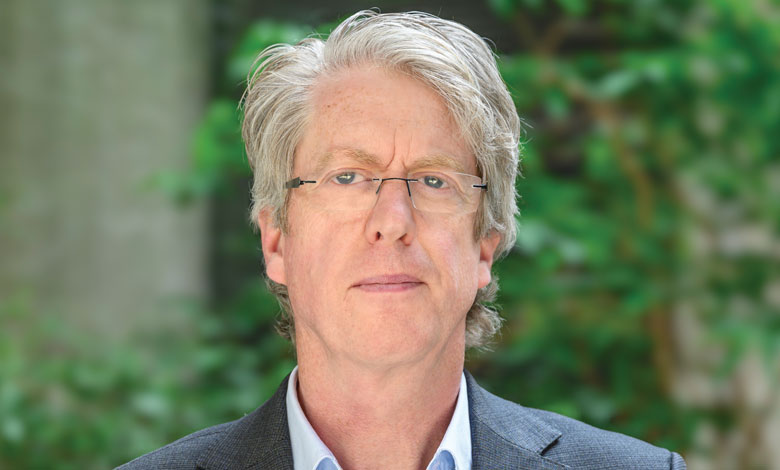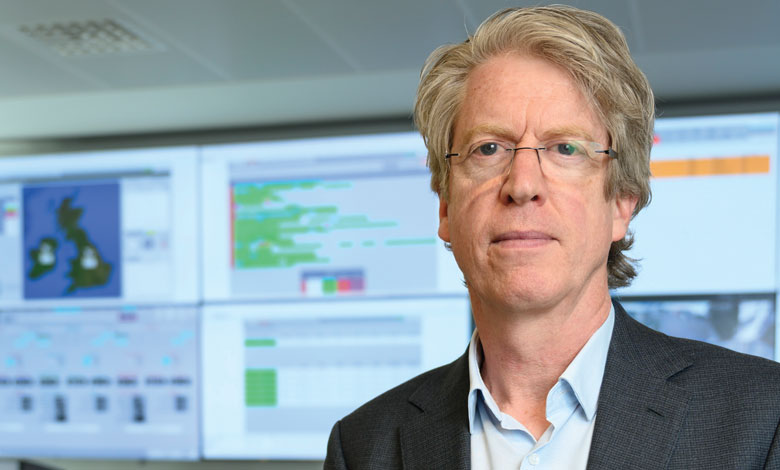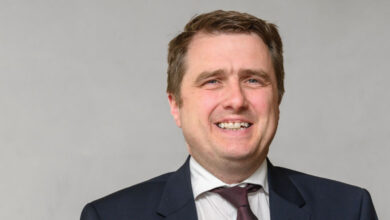Decarbonising our electricity system

In an exclusive interview with eolas Magazine, ESB Chief Executive Paddy Hayes underscores ESB’s commitment to its net zero by 2040 journey, tracks its progress to date, and addresses the known challenges of delivery.
Recalling the four years since his appointment as Chief Executive (CE) of ESB in the summer of 2021, Hayes reflects on the challenges presented by the energy crisis, extreme weather events, and increasing geopolitical uncertainty, challenges that ESB has done its best to navigate on behalf of customers. Guided by its strategy Driven to Make a Difference: Net Zero by 2040, the electricity company has been working to create and connect sustainable, reliable and affordable energy, while supporting customers and communities.
Against that background, the ESB CE was encouraged to read the Climate Change Advisory Council’s most recent review of the electricity sector, which recorded that in 2024, Ireland’s electricity emissions reached the lowest level since record-keeping began in 1990.
“That is an incredible achievement by the whole electricity sector, particularly considering the growth of electricity demand during this time,” Hayes observes. “Of course we need to go further and faster but, reflecting on what the sector has achieved, not just in terms of progress towards net zero, but also in terms of supporting wider socioeconomic growth over the last number of years, it is an encouraging platform to build on for the future.”
Progress to date
Specifically, Hayes identifies progress against ESB’s three strategic objectives of:
- decarbonising the electricity system;
- building resilient infrastructure; and
- empowering customers.
“Firstly, it is very positive to see how the whole sector – including government, regulators, EirGrid, generators, and retailers – has been stepping up to decarbonise electricity; building and connecting renewables in a way that has also promoted and supported energy security and energy independence,” he says.
“Secondly, the importance of continuing to invest in both resilient networks and network capacity is clear. While resilience may be increasingly challenged by more frequent extreme weather events, ESB is determined to bring innovation, its delivery capability, and a willingness to collaborate to meet that challenge.”
Thirdly, ESB has made tangible progress supporting and empowering customers to increasingly use clean electricity to decarbonise. Hayes points to the ESB ecars network of 1,600 public EV chargers across the island of Ireland, to the deep home retrofit service offered by Electric Ireland Superhomes (a joint venture with Tipperary Energy Agency), and to the smart meter tariffs offered by Electric Ireland, the company’s retail arm, which allow customers to tap into cost savings based on time of use.
Prevailing challenges
Pursuing this journey to net zero by 2040 is not without its challenges, particularly around the construction of renewable generation and network infrastructure. Asked to identify the standout challenges, Hayes points to three.
Firstly, he emphasises supply chains. “The impact of geopolitical uncertainty coupled with concentrated demand is challenging supply chains, both extending delivery times and putting upward pressure on costs. Ireland is far from the only country working hard to decarbonise – so demand for equipment is strong and lead times have extended. It is highlighting the benefit of long-term contracts and relationships with reliable suppliers.”
“The considerable progress the electricity sector has made is clear to see – the challenge now is to continue delivering at pace.”
Paddy Hayes, CEO, ESB
Extreme weather events
Secondly, the ESB CE acknowledges the impact of climate change and more frequent extreme weather events, such as Storm Éowyn in January 2025. “The hurricane-level wind speeds of Storm Éowyn had never been recorded before in Ireland and had a very significant impact on our customers and networks.”
The possibility that Ireland will experience winds at those speeds on a more frequent basis is a key focus for ESB Networks’ future planning: feeding into its winter resilience plan for this coming winter, a review of storm response procedures, and a re-assessment of the scope of its plan for the upcoming Price Review 6 (PR6) period in respect of climate adaptation.
“We cannot mention Storm Éowyn without acknowledging the impact that it had on customers,” reflects Hayes. “As dependence on electricity grows, we are determined to increase resilience – and this will be a major focus for the rest of 2025 and beyond.” In this context, Hayes pays tribute to “the ESB Networks and NIE Networks teams who, together with contracting partners, international support crews and volunteers from other parts of ESB, showed outstanding commitment to restoring power and supporting customers.”
Planning and public acceptance
Finally, the ESB CE addresses planning and public acceptance as key elements of infrastructure delivery. Welcoming the Government’s commitment through the Planning and Development Act and the allocation of additional resources to the planning system, Hayes acknowledges that ESB has “seen some projects move quickly through the planning process, often where there is already a footprint or experience of infrastructure in the vicinity”.
“It is understandable that concerns can be raised by local communities, and it is important that any such concerns are addressed,” he points out. “While it can be easier to get public support for infrastructure directly associated with local projects, acceptance of the need for and positive impact of regional and national projects is so important. Electricity infrastructure has unlocked many benefits for local communities, regions and for Ireland in the past – and much more will be required over the next 10 years to support the country’s continued social and economic growth.”
Growing demand
Ireland’s ongoing electricity demand growth stands in contrast to reductions in demand experienced in other European countries in recent years. “This rising demand is a great indicator of positive social and economic development and electrification,” says Hayes, “but, of course, the pace of growth presents a challenge.”
“While ESB is just one part of the electricity generation capacity equation, it has a strong pipeline of development projects. Recently, ESB has commissioned flexible engines at three locations around Dublin to provide additional generation capacity and has worked with EirGrid to provide additional temporary capacity at North Wall in Dublin and Shannonbridge in County Offaly. Construction is underway on a new gas turbine plant in Poolbeg and, adding that to the 300MW of grid-scale batteries that ESB recently commissioned in Cork and Dublin, all told that provides a positive support for energy security and a valuable response to a growing peak demand,” Hayes explains.
Network
ESB Networks has been scaling up, increasing investment and delivery of transmission and distribution projects over the past five years. “ESB Networks is now working with CRU and Eirgrid on the PR6 plan that sets out proposed investments for the five years from 2026, and it is clear from ESB Networks’ public consultation process that their expectation is for even more investment and enhanced delivery,” Hayes forecasts.
While capacity has been added to the electricity network to support new housing and business connections and greater electrification, challenges can arise when the pace of demand growth exceeds typical timelines for infrastructure development. This brings the discussion back to planning and the public acceptance of electricity infrastructure and underlines the importance of programmes like PR6 to invest in capacity in advance of demand.
At the same time, ESB Networks has been working quietly to facilitate farmers, homeowners, and small businesses to export renewable electricity from solar panels on their roofs. In 2024, it announced that over 100,000 rooftop solar microgenerators were connected to Ireland’s electricity network, capable at peak of providing over 400MW of clean electricity, the equivalent capacity of Ireland’s largest gas turbine power stations.
Asked about the most exciting projects being undertaken by ESB currently, Hayes points to the evolution of Moneypoint Power Station situated on the Shannon Estuary. “There are many exciting projects in progress across the group but the work happening at Moneypoint right now is particularly relevant, as we expect to announce the end of coal generation this summer – a key milestone on the path to net zero.
“Bringing coal-fired power generation in Ireland to an end is a major step – both tangible and symbolic – in the decarbonisation of the electricity system.”
“Moneypoint has been an absolute powerhouse, anchoring the Irish electricity system since the 1980s,” Hayes observes. “Now, having installed wind turbines and a synchronous compensator on the site in recent years, the staff in Moneypoint and the project teams involved deserve great credit for bringing this transition forwards.”
In agreement with Eirgrid and the CRU, the successful project to prepare the plant for a standby role, supporting system security, “is bringing coal-fired power generation in Ireland to an end. Following ESB’s transition away from peat generation in 2020, this is another major step – both tangible and symbolic – in the decarbonisation of the electricity system,” he says.
Offshore
Elsewhere, the Neart na Gaoithe offshore windfarm off the east coast of Scotland – jointly owned by ESB and EDF Renewables – became fully operational in May 2025, generating 450MW of clean electricity, building on ESB’s earlier investment in the Galloper project off the coast of East Anglia.
Meanwhile, Hayes gives credit to the project team for another ESB joint venture, the 1.1GW Inch Cape offshore windfarm, co-owned with Red Rock Power Limited, also off the Scottish coast. “The Inch Cape team showed great capability and determination to steer the project successfully through financial close and into construction recently, no mean feat at a time of global economic uncertainty.”
“ESB expects to be leveraging this experience to deliver projects like Inch Cape and Neart na Gaoithe off the coast of Ireland in the near future,” the ESB CE asserts.
Technology
Turning to the role of technology in the journey ahead, Hayes speaks enthusiastically about the pace of development in the last decade. “There are technologies being deployed – such as grid-scale batteries – which 10 years ago were only in development, and older technologies – such as synchronous condensers and static compensators – being applied for new purposes, enabling greater integration of renewables and secure delivery of less carbon-intensive electricity,” he explains.
“Likewise, there has been huge innovation on the demand side, with new technologies supporting greater flexibility and customer involvement in the energy system.”
Looking ahead, the ESB CE believes that identifying a means of cost effective long-duration energy storage is “an imperative for Ireland’s future electricity system”. He suggests that “we have around 10 years to realise that ambition”, and, in the immediate term, “it is really important that we continue to pay attention to that”.
Affordability
Hayes is quick to acknowledge the importance of electricity affordability for residential customers and competitiveness for business.
“There is a strong and growing focus on affordability and competitiveness,” he says. “Wholesale electricity prices have reduced somewhat since the height of the energy crisis which followed Russia’s invasion of Ukraine in February 2022, but they remain much higher than they had been. While Electric Ireland has delivered three consecutive electricity price reductions in a very competitive retail market over the past 18 months, the electricity sector is aware that affordability remains a key challenge for customers.”
While some ask whether questions of affordability challenge the continued investment in renewables, Hayes explains that “only renewables can give us independence from the volatile price of international gas in the immediate future. To mitigate our exposure and reduce price volatility, it makes sense to build out more renewable generation, particularly offshore wind”.
People
With over 9,500 people working across its business, ESB has been on a recruitment drive in recent years to support the increased pace of delivery and growth.
While people have been recruited at all levels of the organisation, Hayes is particularly keen to discuss apprenticeships. “At the moment we have around 500 apprentices training across the ESB group, from craft apprentices in power stations and apprentice technicians in NIE Networks and ESB Networks, to business apprentices in insurance, accountancy, HR, and data analytics.”
“ESB Networks has grown the annual intake into its four-year apprenticeship programme from 60 traditionally to 100 more recently and is expanding further to 150 in September 2025, and there has been a really positive growth in the numbers of women coming into craft roles. It is a fantastic programme and a huge investment, but very much worth it for the future.”
Programme for Government
Reflecting on the 2025 Programme for Government, Hayes welcomes the Government’s “ambitions for the development of Ireland”, alongside the review of the National Development Plan (NDP) set to be completed in July 2025. “That is an important process for ESB, and we want to ensure that everything we do is aligned and that we deliver whatever is necessary to support the new NDP and the latest Climate Action Plan,” he says.
Vision
Asked whether ESB is meeting the pace required to decarbonise by 2040, Hayes points to the progress that has already been made, even at a time of electricity demand growth, which supports the belief that ESB and the rest of the electricity sector will deliver. “We have built a development portfolio which will enable us to greatly decarbonise generation by 2040. The challenge now is to continue delivering these projects at pace while finding solutions for the economic long-term storage that will allow the capture of clean electricity at times of surplus, so as to be able to offer it back to customers when needed,” he says.
In summary, the ESB CE remains optimistic and confident. “The considerable progress made on the decarbonisation of the electricity system, in terms of both capacity and the expansion of infrastructure, is clear to see. While continued demand growth brings a challenge, I am confident that we – we as in ESB, and also the wider electricity sector – are up for it and, together, we will deliver.”







